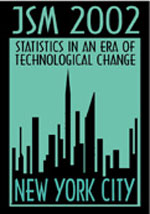|
Activity Number:
|
279
|
|
Type:
|
Contributed
|
|
Date/Time:
|
Wednesday, August 14, 2002 : 8:30 AM to 10:20 AM
|
|
Sponsor:
|
Section on Statistics in Epidemiology*
|
| Abstract - #301477 |
|
Title:
|
A Joint Hierarchical Model Approach for Competing Risk Analysis in Analyzing Different Types of Cancer Mortality
|
|
Author(s):
|
Fei Yu*+ and Gang Li and Yingxu Zhao and Beate Ritz and Thomas Belin
|
|
Affiliation(s):
|
University of California, Los Angeles and University of California, Los Angeles and University of California, Los Angeles and University of California, Los Angeles and University of California, Los Angeles
|
|
Address:
|
, , , ,
|
|
Keywords:
|
Competing risk analysis ; Hierarchical model ; Cox proportional-hazards model ; Job-exposure matrix
|
|
Abstract:
|
Competing risk analysis allows investigators to distinguish different types of end-points and to model them separately in a unified survival analysis. Allison (1995) suggested that a separate survival model for each event type is equivalent to a joint competing risk analysis without loss of statistical precision, because the joint likelihood function for all event types can be factored into separate likelihood functions for each event type. In this study, we extend the competing risk analysis by fitting Cox proportional-hazards models simultaneously for each event type so that we can integrate a second-stage regression model with higher-level covariates. The motivation of this joint hierarchical model approach for competing risk analysis comes from our analysis of a historical worker cohort study of job related chemical exposures and cancer mortality (Rocketdyne study), in which effects of workers' job titles on different types of cancer mortality are estimated from the competing risk model at the first stage, and chemical exposures derived from a job-exposure matrix are used to inform the second-stage regression model.
|
- The address information is for the authors that have a + after their name.
- Authors who are presenting talks have a * after their name.
Back to the full JSM 2002 program |

